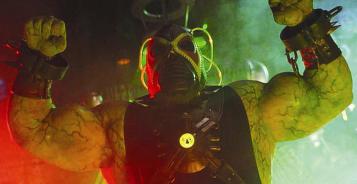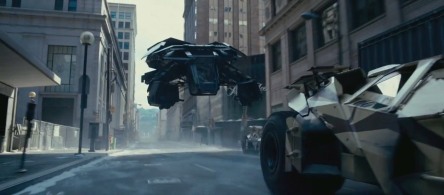Has it really been only four years? The Dark Knight was such an enormous success on its release in 2008, both critically and popularly, that it upended the common perception of the summer blockbuster as infantile or mindless. Already a regular on many film fans’ favourite movies lists, it has even repeatedly permeated somewhat hyperbolic lists of the “best films ever”. Regardless of negative opinions some might have, there is no denying it was a step above the Hollywood machine’s average output, and, to borrow from the Joker, it changed things.
So expectations were high, probably too high, for The Dark Knight Rises, the “final act” in Christopher Nolan’s Batman trilogy. Following on from the remarkable success of The Dark Knight (and the director’s popular, inspired, flawed Inception), the loss of that film’s breakout star (Heath Ledger’s Joker is perhaps the most iconic villain of the past decade) and the need to conclude a saga that, in many ways, had only just begun, have proved to be too much for Christopher Nolan and his brother and writing partner Jonathan Nolan to live up to. But while The Dark Knight Rises is the weakest film in the trilogy that started with the brilliant but overshadowed Batman Begins, it does not let the side down and brings the story to an acceptable, if premature, close.
We pick up eight years after the events of The Dark Knight. Bruce Wayne is still physically and emotionally damaged from his encounter with Harvey Two-Face and the death of his beloved Rachel. He has not put on the cowl in that time, but the myth of Harvey Dent as a hero has allowed for the streets of Gotham to be kept free of scum by strictly legal means. Wayne, now a Howard Hughesian shut-in, is led back down the path of the Batman after an encounter with a cat burglar, Selina Kyle (the traditional Catwoman, though never named as such in the film), who is discovered to have links to a conspiracy within his own company and, worse still, connections to a vicious, hulking terrorist known as Bane.
The film opens with an impressive if over-elaborate Mission: Impossible-style airborne action sequence, but slows down rapidly after that, taking its time to reintroduce to us to a very different Gotham, as well as a few new characters. It’s not until the 45min mark that Wayne is back in the Batsuit, chasing Bane and evading the police. The film becomes quite gripping from here on, as Batman tackles Bane and his henchmen, with a little help from the slippery Selina, before the revelation of Bane’s masterplan brings the film to a screeching halt. Dragging out the penultimate half hour with a bloated, convoluted and frustratingly unauthentic city-under-siege scenario, it is only in its final action sequence – a massive street brawl and a pulse-pounding chase sequence – that the film fully recaptures the viewer’s attention and excitement. One can’t help but feel there was just too much story for one movie here, and the scale was simply too big for the subject.
Despite a handful of surprisingly predictable plot twists in the final act – hardly believable from the men behind Memento and The Prestige – the story is strong and the dialogue is tight. The Nolans have done a good job returning to the themes of the previous movies – identity, justice, chaos – and extending them through this film, although they touch upon little new. The simplicity of the Joker’s master stroke in The Dark Knight – bombs on two boats with the triggers in the hands of the passengers of the alternate boat – is here echoed and extended to ludicrous proportions, dragging out the sense of terror and chaos. An earlier scene where Bane detonates a bomb at a sports stadium and threatens the spectators with more to come creates far more panic and horror than what actually follows.
Linking Bane to the League of Shadows, the terrorist guild from Batman Begins, helps to bring the story full circle, and Wayne’s character arc comes to a well-executed conclusion. Perhaps The Dark Knight’s greatest flaw was taking the focus away from Wayne and Batman, but here his struggle is once again at the forefront of the drama. Christian Bale continues his restrained performance as Wayne/Batman, though has little new to show off that he didn’t in the first film. His only real challenge is in the romantic subplots, balancing attractions to femme fatale Selina Kyle (Anne Hathaway) and charitable billionaire Miranda Tate (Marion Cotillard). These subplots don’t run smoothly, but Bale captures something of a man who desperately needs to be loved but cannot admit it.
Disappointingly, the refocus of attention on Wayne comes at the expense of the minor characters, Alfred (Michael Caine), Commissioner Gordon (Gary Oldman) and Lucius Fox (Morgan Freeman). All three were given brilliant, short, simple character arcs in The Dark Knight, but here are reduced to their basics. With the exception of one emotional scene with Bale, Caine’s Alfred is little more than a butler. Gordon, now one of the few devotees of the cult of the Dark Knight, offers unconditional, undramatic support – although Oldman gets a chance to have some fun during the final action sequence. Fox is once again just black Q.
Thankfully the Nolan brothers have found something special in their interpretation of Selina Kyle. Treating her as a Robin Hood-esque thief who believes the rich should sacrifice all their belongings, but still wants to keep the good stuff for herself, the pair have written a strong, feisty female role that it is both witty and sexy, and Anne Hathaway pulls it off with ample aplomb. Christopher Nolan has often (and justifiably) been criticised for the weak female characters in his films, so his Selina is a welcome addition, and the strongest woman to feature in a Nolan film since Memento. The fact that Hathaway kicks plenty of ass in a skin-tight catsuit with serrated stilettos makes her fanboy gold.
More problematic is new character John Blake, a rookie cop whose smarts soon raise him to the rank of detective, and who becomes a close ally of Gordon and Batman. It’s not that he is a weak or thinly drawn character, but that the story forces him upon the viewer. Before we’ve had a chance to get a sense of the character he rattles off a story about his childhood that screams “Like me! Like me! I’m an important character!” You can feel the hand of the writers at work, and it’s disconcerting. In the hands of a lesser actor it would have been a disaster, but, portrayed by the immensely charismatic Joseph Gordon-Levitt, Blake is elevated and carried through the story. It was a close call, though.
And then there’s Bane. Played by a beefed-up Tom Hardy, the massive enemy has impressive screen presence, but not much more. With his face half-covered by a breathing device, and his voice echoing like a less-sleepy Orson Welles from Transformers: The Movie, Hardy’s performance can barely be seen. His mouth is completely cloaked, so it is his eyes and hands and body that do the acting. He is never quite dull, but he is truly limited, and many of his lines, laced with Nolanesque menace, are inaudible in the troubled sound mix. In many ways this Bane is little more than the previous cinematic incarnation of the character, as a grunting henchman in the lambasted camp farce Batman & Robin.
Production values are as high as one has come to expect, and Nolan’s camera never misses a chance to show off the glossy grit on display. The choice to film an undisguised Manhattan as Gotham is an odd one, however. Several famous landmarks can be seen in wide shots as bombs go off, including the half-constructed new World Trade Center. The illusion is briefly shattered. But the action scenes are gloriously paced and captured, particularly the high-speed chases. The fight scene choreography is a bit lax, and one punch-up between Batman and Bane is out of focus for a disappointing amount of the time. CGI is well used to show the scale of Bane’s warpath, but one longs for an on-set demolition, like the hospital in The Dark Knight.
Editing is quick and clean, although Nolan relies too heavily on flashbacks, particularly to the less-seen Batman Begins, to make sure that everyone is up to speed. Further patronising can be witnessed when a minor character is killed and the camera whips in to a close-up on their body and lingers there until people who aren’t even watching the movie have all understood that yes, this relatively unimportant character is now dead. “Have you got it yet? They’re dead. Right? Yes? Let’s move on.”
What the film lacks in balance it makes up for in style and scale, and there is so much to enjoy here, despite its exhausting length. Much of the wit of Batman Begins lost in The Dark Knight is back this time round. There are more one-liners, with two of the film’s finest lines delivered by an unexpected but well-chosen character. Wittier than The Dark Knight though it is, it takes itself even more seriously, if that can be believed. Hinting at issues such as class struggle and the Occupy movement is all well and good, but you need to back them up with conclusions that are absent here.
Still, while Nolan has delivered the weakest film in his trilogy, he has still delivered a fine third instalment, and this trilogy will be immortalised for his incredible efforts. Rises is a better film because of the films that have preceded it; the characters already developed, the music carried over, its brilliant look and dramatic style. It brings little new to the table, but it repackages the old things with a sizeable punch. While its climax is overly predictable and oddly familiar, it is a suitable denouement.
Nolan’s Batman may have finished his work, but the inspiration this series of films has provided audiences with will linger, and we will no doubt see the character again soon, in this guise or in another. The bar has been set for all future Batmans, and thanks to The Dark Knight Rises it is still an imposing height to reach.
3/5







Reblogged this on the dweebster and commented:
Don’t read just yet if you haven’t seen it. There might be a spoiler or two in there. You have been warned!